Colorful Yunnan
Temples and pagodas in a beautiful mountain landscape
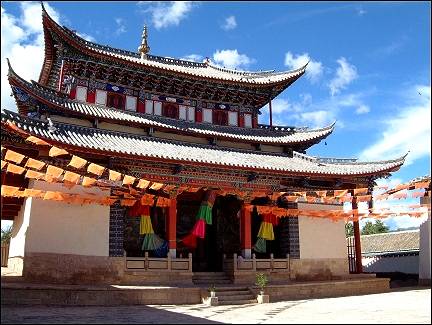
|
In the South Chinese province of Yunnan tourism is booming. This is notable in cities like Kunming, Lijian and Dali. Hiking in the wild Tiger Leaping Gorge with its 3000 meters high walls is increasingly popular. But in villages the numerous minorities in this border province still live their traditional lives. A wedding of Chinese friends is an opportunity to get a more intimate impression of life in Yunnan.
Travelogue & photos: Geja Rijsman
We fly to Kunming, the capital of Yunnan province, via Beijing to attend the wedding of Erwin and Yang . May grew up in Yunnan and her family still lives here.
On our first night in Kunming we take a walk in the neighborhood of our hotel and end up in a restaurant. All dishes are on display and are prepared within view. We pick a table outside, on the street, with diminutive stools. We get acquainted with Yunnan's culinary specialities: pig tail and sinew.
Next day we visit Cuihu Park, which is mainly used by the elderly and parents with small children. Everywhere are tables where people play mahjong, Chinese chess or other games. In other places, people are playing music and singing.
There are temples and ponds with huge fish in the park, which offers a view of the skyscrapers of Kunming.
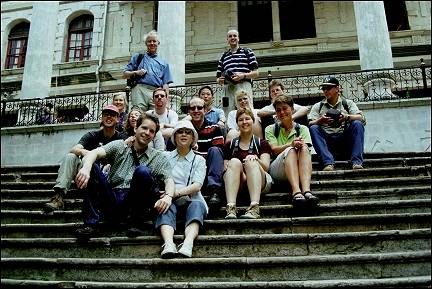
|
We leave Cuihu Park and walk to the nearby University of Yunnan. May studied English here. The campus is on a hill and everywhere students are studying for tests.
May tells us about life at the university. The dormrooms are shared by eight students (men and women seperate) and have their own bathrooms. There always are long lines for the showers.
We have lunch in the famous "Over The Bridge Noodles." The restaurant's speciality is a hot broth in which you cook fresh vegetables and other ingredients. It's delicious.
Qujing
On the BBQ lie pig entrails, chicken stomachs and lots of tofu
A bus takes us to Qujing in the eastern part of Yunnan, 157 kilometers from Kunming, in a heavy rain and thunderstorm. From the ShuHan Kingdom (221-263) until the early Tang dynasty it was the political, economic and cultural center of the province. Nowadays Qujing is the second city of Yunnan.
The busdriver is nice enough to drop us off at our hotel, after asking the other passengers' permission; they don't mind.
In Qujing we visit May's parents in their second home. We eat in a restaurant which is owned by relatives of May. During dinner, May's aunts and uncles join us at our table. They travelled to Qujing for the wedding. They smile at us, but unfortunately don't speak a word of English.
Next day is the first wedding party. In the morning we wait in our best clothes for May to arrive in a beautiful black car, decorated with flowers.
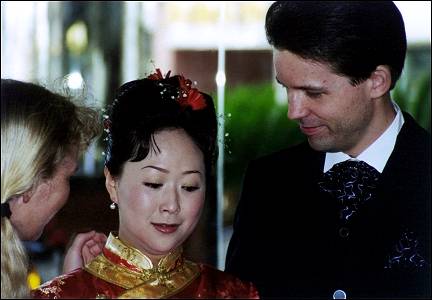
|
Because her mother insists that everything should go according to tradition, May can't choose her own make up and hairdo. She hates how she looks and is afraid that the make up wil crack when she smiles. We think she looks special and from a distance you don't notice how much make up she is wearing.
Before the party we have time to visit a market. It covers a few streets and the main merchandise is meat, duck and pig snouts, but also peppers, rice and herbs.
Around five the first guests arrive. Everyone puts a red envelope with money for the bridal couple on a tray and takes cigarettes and candy from it. Then they enter the restaurant (sometimes even without greeting the bride and groom) and sit down at one of the 30 tables which each seat 10 people.
When we enter, we notice that we are a curiosity. Everyone stares at us. We sit down at a table in front of the stage and have a great view of the ceremony. May en Erwin have to step up to the stage and some lady tells about weddings in China. Wan Quan Yan, a friend of May who is an interpreter, translates everything into English for us.
After the mutual parents have spoken, the Kow Tow ritual begins: first Erwin and May make three bows to their parents, then three bows to the guests and finally three bows to each other. The ritual ends with Erwin carrying his bride to their table, while children shower them with confetti.
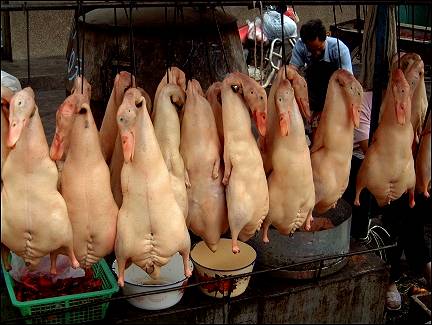
|
During the ceremony the food was already placed on the tables and the guests immediately started to eat. When Erwin and May are just seated at their table, the first guests are ready to leave. This means that they, their parents and their witnesses have to be near the exit to say goodbye. They still haven't eaten anything.
The party is over soon. Afterwards we take a walk to Forest Park near our hotel. Then we join May's friends and brothers on a visit to a karaoke bar. Karaoke is popular in China and karaoke bars are virtually the only entertainment.
After the karaoke May and her friends are hungry and want to go to a street barbecue, just like they did when they were students. We move to a street with barbecue restaurants.
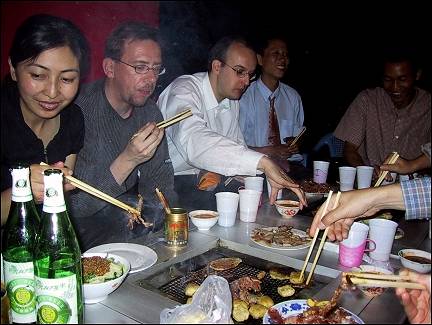
|
On the grill are pig entrails, chicken stomachs and lots of tofu. I don't like most of the meat, so I take little of it, but the tofu is delicious. Of course everything is washed down with Chinese beer.
Huize
A man walks up a hill carrying a huge load of pine-needles
Next day the bus picks us up at our hotel and takes us to our hotel in Huize, a small town northeast of Kunming.
In Qujing there were no other tourists either, but here people stare at us. May's brother and sister live here and May lived here, too.
That night we again have dinner in a restaurant owned by relatives of May. Each table sits in its own alcove. Because we're so many, our company occupies three alcoves, which is less cozy then when you're able to see everyone.
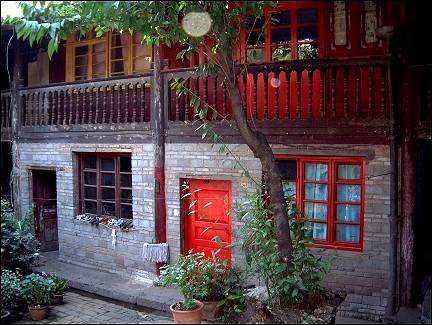
|
Next morning we visit one of the little houses where the Yang family lived. Those weren't easy times: they had to take care of the grandparents and May's sister needed surgery because of polio. There was no electricity, but now there is.
We eat breakfast near May's old house. It's not tasty, but it is a local speciality: long dough strings, friend in oil, are dipped in soy milk. The mild is burnt, which doesn't help.
After breakfast we visit a temple named Wanshou on Huize Jinzhong Mountain.
The temple consists of a group of small buildings; it's not used anymore and is not very atmospheric. But the buildings and especially their roofs are pretty.
After seeing the temple we climb the mountain behind it. The path goes straight up the mountain, which makes the walk exhausting.
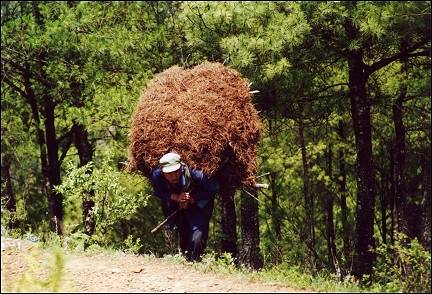
|
Half-way we take a break near a little house. While we sit there, a man carrying a huge pile of pine-needles walks through the forest up the mountain. Even though his back is bent under the burden, it doesn't seem to take any effort.
We follow the man for a while to a pass. There he sits down to rest and we sit down near him and enjoy the view.
From here we descend. It's almost as steep as the way up. Even though descending takes less energy, we have to be careful and we still don't go fast.
In the afternoon we eat the local speciality: a kind of jelly, made of pressed rice and a combination of cabbage with slices of pressed beans. It's a little slimy, but with soy sauce it's tasty.
Next afternoon there's another wedding party, but in the morning we visit the market near our hotel. Via a street where only meat is sold, we reach the indoor market. Here the merchandise is mainly vegetables and fruit. Everything looks clean, fresh and attractive.
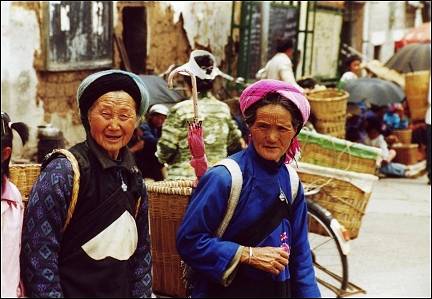
|
From the market we walk to the shopping street. I guess they don't often see such tall, blonde people. We also look around in amazement. A few people wear traditional garb, but the majority walks around in dull uniform blue.
Before the second wedding party we visit the second largest earthen dam in the world, a few kilometers outside Huize. We take a short walk there. Erwin has to pick flowers for his bride.
We take a ride with two boats which are docked near the dam. The boats move fast in circles around each other. In our boat is a camera crew, in the other one May and Erwin stand at the bow in Titanic style. Every time the boat takes a turn, we hear May scream.
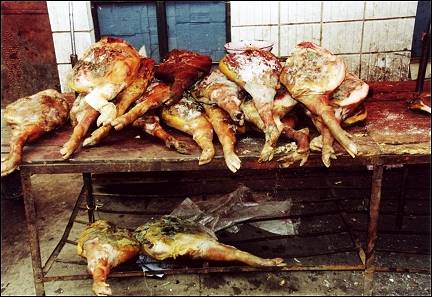
|
After the boat ride we take another walk to the market, where we see a huge pile of pig feet, which have been rubbed with something to keep them fresh a little longer.
In the evening the wedding party continues in a large party hall. When we enter, we again are stared at. Our table turns out to be on the stage, next to the bridal couple's one. We never before experienced such a strong feeling of constantly being watched.
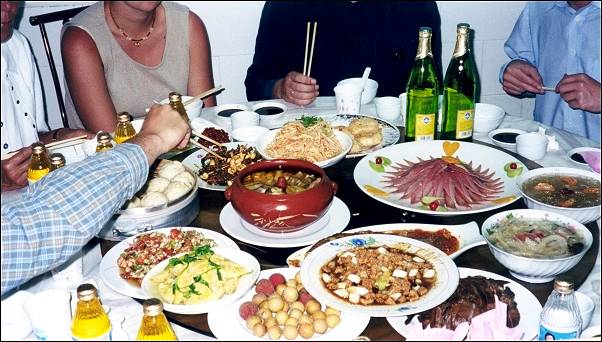
The guests again depart soon, leaving a terrible chaos. In China it's usual to throw leftover food under the table. There is no room on the table, because the the revolving tray takes up 90 percent of the space. There is just enough room for beer, a cup of tea and a bowl for the food.
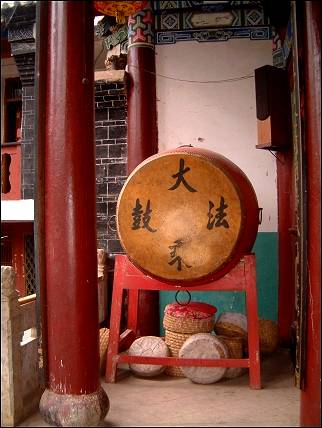
|
On our last day in Huize we visit the Wanshigong temple. It's near May's old parental house. It's beautiful, but no longer in use and rather dilapidated.
We walk through the shopping street to the Buddhist temple on the main street. It is small, well-kept and in use. Especially the gong, the bell and the incense burner are very pretty.
When we sit down on the steps of the temple, the female monk invites us in. Even though we don't know what is expected of us, we sit down on the pillows. The monk offers us lychees and gestures that we should eat as many as we want.
We each eat a few and when it becomes clear that there well be no rituals, we leave the temple, of course after making a donation. We still have time for a stroll on the market. Vegetables and herbs are displayed in such a beautiful way here.
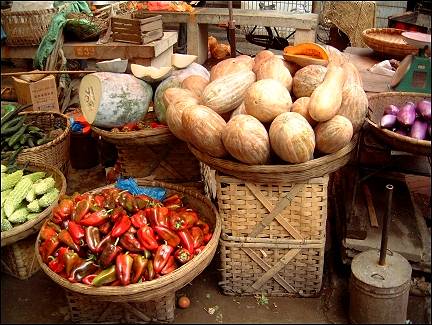
|
In the afternoon we rent three taxi vans to a village just outside Huize. The population here hasn't been influenced by Western culture yet.
A large group of schoolchildren follows us around, but they are afraid to talk to us. Jeroen takes a notebook from one of the kids' bag. While he takes a look at it, the whole class surrounds him.
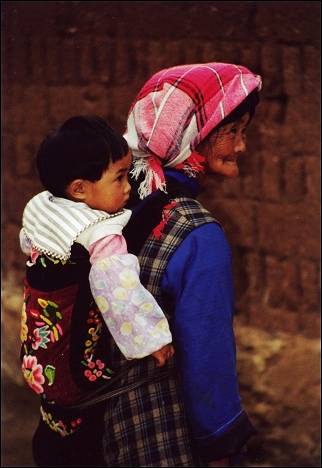
|
Near the village remains of Ming graves have been found and currently they're building a museum around them. When the airport will be ready, this should become a tourist attraction.
We stroll through the village with the group of children and see beautiful people, like a woman doing laundry and an old woman with a child on her back.
One of the children invites us to take a look inside a house. It is a typical Chines house with a sparsely furnished living room, kitchen with a gas cannister and stove and a dusty attic which serves as a bedroom. To thank him, Mike gives the kid a set of miniature earthenware clogs.
Kunming
Bicycle trip to Lake Dianchi and the Western Hills
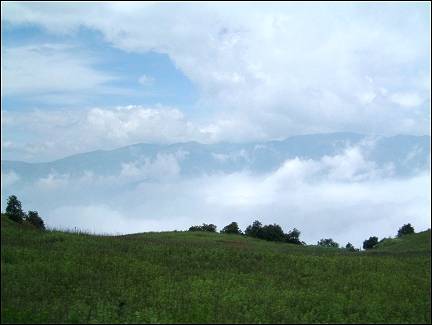
|
Next day we return to Kunming. We pass a valley which is completely filled with clouds. Even the driver and his mate seem to have never seen this before.
Next day we bicycle to Lake Dianchi just outside Kunming. For most of the trip, I bicycle next to Wan, May's friend. I tell her about Holland and ask her about Chinese customs and rules. After one and a half hour we reach the lake.
Dianchi Lake, also known as Kunming Lake or Green Lake, is the sixth largest freshwater lake of China. It lies at the foot of the Western Hills and has a surface of about 300 square kilometers and measures 40 kilometers from north to south.
After taking a look at the lake and the Western Hills, we bicycle to the cable station. Some of us take the cable, the others climb the stairs. The people who walk, reach the Dragon Gate first.
Together we take the path farther up, passing famous temples on the way. There's a great view of Kunming and Lake Dianchi.
Along the path, which was hewn in the rocks between 1781 and 1853 by Taoist monks, there are pavillions, sculptures and caves.
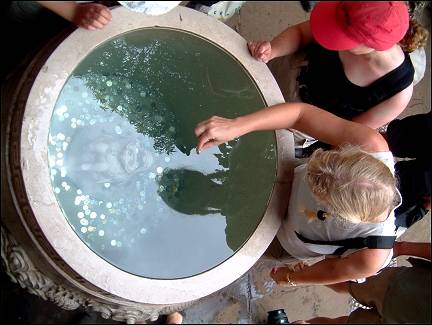
|
Most temples in China have a large water barrel outside. It's supposed to bring good luck if you can float a coin on the water and then drop it in the mouth of the dragen. Unfortunately, I don't succeed.
In the evening we have dinner with the whole group in a very old restaurant. The tables are scattered over rooms which lie around a covered courtyard. There are beautiful Chinese lanterns everywhere.
While we're eating it starts to pour. The waiters panic, because water flows into the restaurant from all sides. Within minutes, there is a few centimeters of water in the courtyard. The tables and chairs are piled up into a kind of tower of Pisa.
Dali
Three pagodas against a beautiful, clouded sky
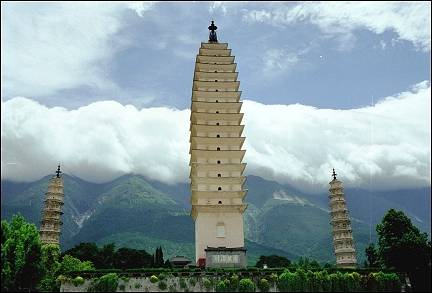
|
Next morning we take an early flight to Dali, 430 kilometers west from Kunming and mainly known for Erhai Lake.
We visit a batik workshop where the process of tying and dying is demonstrated.
We take a look at the San Ta (three pagodas) of the Chongsheng Temple in Dali. These pagodas are a few kilometers outside old Dali in a seperate complex. The middle pagoda was built around 900 and beneath the roof of one of its towers art objects were recently found.
At the entrance to the complex the pagodas are seen against the background of beautiful clouds, swirling around the mountain peaks.
The largest pagoda, Qianxunta, is almost 70 meters high. It was built around 850 and has sixteen layers. The two smaller pagodas each have 10 layers, are 42 meters high and were built two centuries later.
After our visit to the Chongsheng Temple, we go souvenir hunting in Dali's old town center. From the northern gate a long street with many little shops leads to the southern gate.
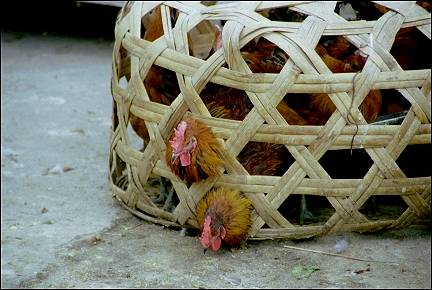
|
In a parallel street are regular stores for the local population. Women in traditional garb look at the merchandise. A little farther chickens are for sale.
The old town center is walled in and the wall is used to display and sell batik cloth.
Lijiang
A maze of friendly streets and alleys.
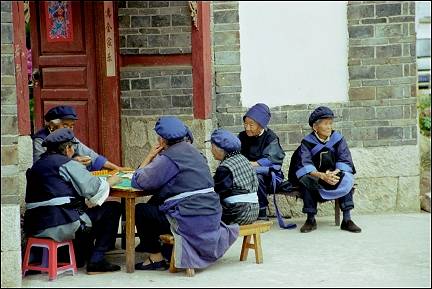
|
This morning we take the bus to Lijiang. This village was put on the World Heritage list of Unesco after an earthquake in 1996.
In Lijiang's town center are wooden maps which help to find your way. The two of us walk to the Black Dragon Pool. This pond lies north of the old town.
On the way we see women in traditional clothes play Mahjong. They live in some kind of home for the elderly. Their blue clothes are typical for the Naxi, who have their own script, painting, music and dance. They are a small ethnic group which holds on to its traditions, despite the influences of modern life.
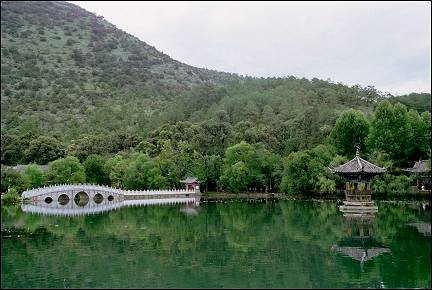
|
One of their traditions is the reversal of the standard gender-roles. Women control the money and work on the market, while the men stay home to raise the children, take care of the garden and play music.
The Black Dragon Pool (Yuquan Park) lies at the foot of Xiangshan Mountain, north of the old town center of Lijang in a pretty park with temples and ponds full of fish. Under the Shuocui Bridge a waterfall produces a constant rumbling. Everywhere are willows and chestnut trees; nice paths meander between the lawns.
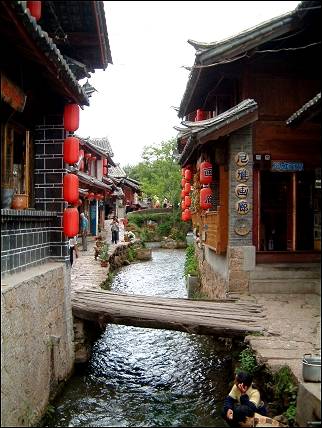
|
Lijiang's old town center is in Dayan, a Naxi town, built during the Song dynasty, 8 centuries ago. In 1997 Unesco put Lijiang on the list of the world's most important cultural heritage.
With Sifang Street at the center, the city spreads in all directions in a maze of friendly streets and alleys.
Most houses, on the foot of the mountain or on one of the rivers which flow through every part of town, are built with tiles and stones and have woodcarvings and painted windows.
Small stone and wooden bridges span the rivers. Red Chinese lanterns hang all over the place, making it look even nicer.
The Naxi are known for their old musical tradition. Lijiang has four traditional orchestras in which traditional instruments like the flute, three-string banjo, Chinese lute, gigantic cymbals and a fish-shaped wooden drum are played.
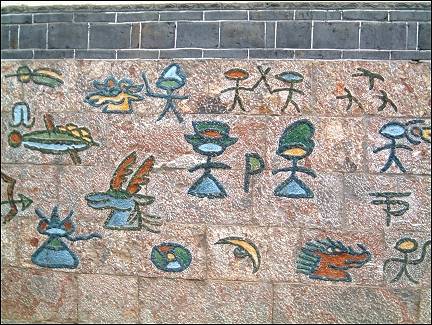
|
The Naxi language is written with pictograms, like the hieroglyphs of the ancient Egyptians. They can be seen on walls of buildings in several spots in town.
Southwest of Lijiang's center is Chief Mu's palace, a reconstruction of a Ming-era building. The original palace was destroyed during the Qing dynasty and the remaining porches were removed by the Red Guards. The palaces look like the ones in the Forbidden City in Beijing. An inscription over the entrance of the complex says "Let us read," a reflection of the Naxi passion for knowledge.
Baisha
The Naxi orchestra's music takes a little getting uses to
Next day we visit Baisha, 10 kilometers north of Lijiang. This village became famous because of a publication about Doctor Ho and ever since crowds of tourists have traveled there, with dire consequences.
Especially around the village center and the Great Precious Storehouse Temple (Dabaoji Gong) are pushy beggars. On the way from the parking lot to the temple are all kinds of stalls with annoying merchants.
At the entrance of the temple complex a group of Naxi is playing music. It's clear they're not enjoying it, because after playing for a very short while, they stop and ask for money. Women in traditional garb sit at the entrance of the temple itself and when Michael takes their picture, he has to pay.
We walk around with flashlights in the temple to see the murals. They are supposed to be colorful, but they are covered with a layer of brown dirt. But there are beautiful wood carvings. An important wooden sculpture has unfortunately disappeared without a trace.
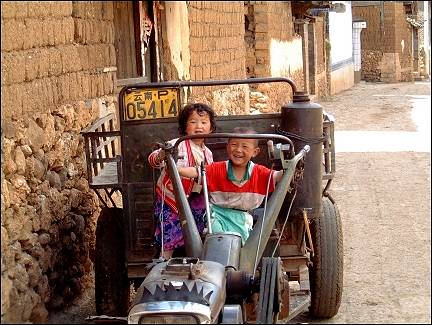
|
After our visit to the temple we leave the village center, where we meet friendlier people and see nice little houses with racks in their courtyards on which the wheat harvest is drying. Playing kids entertain themselves with dad's converted tractor.
<We continue our walk to Wenmingcun to see the Dragon Spring Temple (Longquansi). Wanmingcun is a pleasant village and the population is amiable.
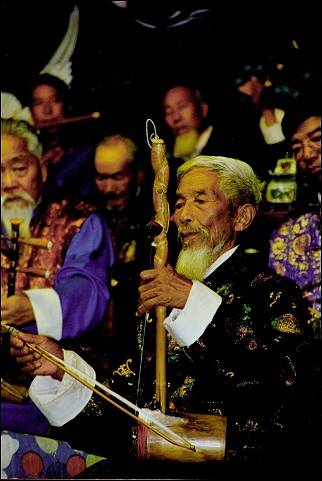
|
The temple turns out to be dilapidated. It's a small temple with an also neglected garden. The god on the main altar is made in Dongba style and the surrounding Chinese characters mean "luck for every family". The murals all have been destroyed, but some of the wooden doors, windows and handrails are beautifully carved.
On our last night in Lijiang we have dinner in a restaurant with a view of the Yulong Xueshan, one of the most southern glaciers in the northern hemisphere. Shanzidou, the highest peak of the mountain at an altitude of 5,596 meters above sea level, looks like a dragon and is covered in snow all year round. The Yulong Xueshan is 15 kilometers from Lijiang and behind this mountain is the Tiger Leaping Gorge.
In the evening we attend a concert by one of the Naxi orchestras which recently gave performances in Europe and the US.
The music takes a little getting used to. And when the ladies open their mouths, you can only hope that the song will be over soon.
Tiger Leaping Gorge
Hiking through the deepest canyon in the world
We take our leave of May's family. Mu, a local guide, wil accompany us on a hiking trip through the Tiger Leaping Gorge, a canyon northwest of Lijiang. Our route to it passes by the Haba Snow Mountains. The bus' wheels are often on the very edge of the mountain road to make room for an oncoming truck or bus. Jade Dragon Mountain on the other has inclines of 70-90 degrees, so road construction is out of the question there.
The Jinsha River flows through the gorge. It is the first part of the Yangtze River and is 150-350 meters wide around Shigu. The river flows leisurely from Shigu to Xiaqiaotou and ships up to 30 tons have no problems here. Downstream from Xiaqiatou there is a strong current, and the river is only 30 meters wide. Further downstream, the river is blocked by the Tiger Leaping Rocks.
De Tiger Leaping Gorge is 17 kilometers long and it falls 300 meters in a series of 18 rapids. The gorge is between Yulong Xueshan Mountain in Lijiang to the Haba Xueshan Mountain in Zhongdian and is supposed to be the deepest canyon in the world with its 3000 meters high walls.
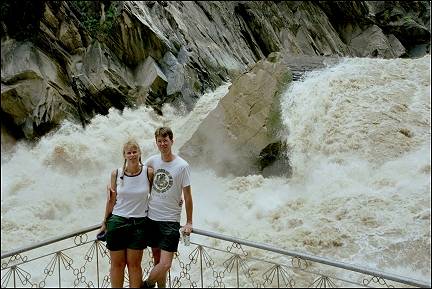
|
Near the village Qiaotou we descend to the Jinsha via stairs and from the plateau there we admire the first Tiger Leaping Stone. In the canyon are three stones which claim the title of "the" Tiger Leaping Stone. The canyon owes its name to a legend which tells that a tiger once jumped over it via a rock.
The path meanders upward slowly during the first part of our route. Every now and then we pass by a few houses and see local people who are taking their horses, donkeys or goats from A to B. After the first steep part, the path gets more level and we enjoy the surroundings at leisure.
On the way we see mountain goats that seem glued to the walls. While balancing, they even manage to fight. After hiking for a few hours, it starts to drizzle. When the rain increases, a wonderful double rainbow appears on the side of Jade Dragon Snow Mountain. Luckily it doesn't take long from here to reach the Halfway Guesthouse, where we spend the night.
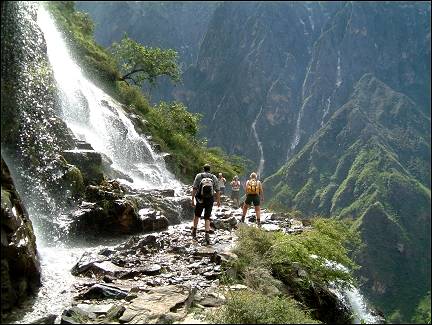
|
Next day we mainly descend. On the way we see lovely terraces. We cross a big waterfall. Everyone takes their time to do so, because slipping is extremely dangerous here.
Early in the afternoon we arrive at Woody's. While I take a rest, the others go see the second Tiger Leaping Stone. The canyon is very narrow here and the river has a strong current.
After breakfast next morning we leave for Daju. The bus drops us at the path to the new ferry. It is a steep path and we often slip on loose stones. At first, there still are some trees and shrubs, but later the surroundings are bare. The rock wall sometimes looks like a slide. Immediately after Wilko slips and falls, his legs dangling over the edge, I loose my equilibrium as well and suddenly find myself sitting on the path!
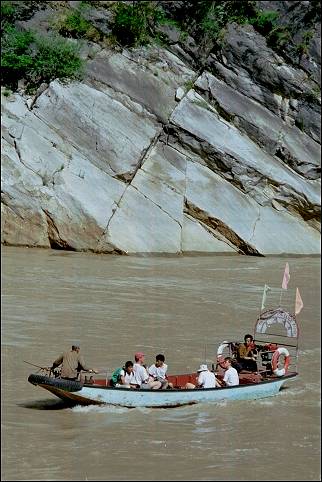
|
The last stretch to the ferry is a path which is hewn out of the rocks. The ferry has to be boarded carefully: if you fall in the river, you're not likely to survive. The ferry offers a great view of the canyon. The current is so strong that we first go upstream for a while, in order not to miss the docking place on the other side.
As we're climbing, the view gets only better. When we reach the top, there's a cabin that sells drinks and where we rest. There's a cab driving back and forth between this cabin and Daju. After ample deliberation we decide to walk back. My back hurts, but because the way to Daju is level, I want to give it a try.
We urge our guide to take the shortcut we found in the Lonely Planet.
Even though it cuts less than we hoped for, walking on the narrow paths in much more comfortable than on the hot road. When we return to the road and the guide tells us we're still far from our destination, I loose courage. My backpain gets worse and it's horribly hot. Eventually we decide to call the cab.
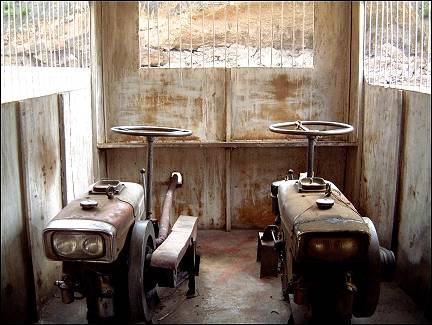
|
After lunch in Daju we take the cab to the path to the old ferry. From here it is a 15 minutes descent to the ferry, which will take us back to the Haba side of the river. This ferry is much larger and it uses two former tractor engines.
Another steep climb to the new Haba follows on the other side. Haba was severely damaged in the 1996 earthquake. With support from the international community a new village was built. The buildings are uniform and we notice that most are uninhabited. The bus is waiting for us here and takes us back to Woody's.
Zhongdian
The bronze bell from 1432 can be heard on the whole mountain.
Next morning we leave for Zhongdian. The road is terrible and it takes a long time to arrive at the Baishuitai terraces. They are close to the Naxi village of Baidi, 108 kilometers southeast of Zhongdian. It is believed that these terraces were formed two to three hundred thousand years ago. Baishuitai was already a tourist attraction during the Tang and Song dynasties.
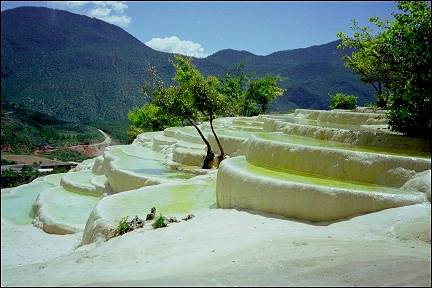
|
The white water terrace is considered the birthplace of the Naxi Dongba cult and is a pilgrim site. In March, when the water reaches its highest level, thousands of pilgrims come to the area to honor the wells and the terraces.
The water is supposed to heal and barren women come here to drink from the well. Nowadays one can only enter the highest pond, the other terraces are fenced in. The Baishuitai terraces are often compared to the Pamumukale in Turkey.
We take the bus to Zhongdian. We have to look for the old town center. It has Tibetan houses and a rural atmosphere. We see a pagoda and a temple on the hill behind the old center and we climb to them. It is very hot in this high-lying town and it is a steep climb.
The pagoda is dilapidated, so after a short rest, we continue our walk to the temple. I turn all of prayer wheels, but we're afraid to enter the temple itself, becouse two large dogs are barking furiously at us.
Luckily a young monk comes running to us and after he has unsuccessfully tried to find a picture of the Dalai Lama in our guide book, he invites us inside. The dogs are still furious and try to climb the wall to get to us, but luckily the chains are short and strong.
The temple is also dilapidated and inside there are stacks of stuff like incense and candlesticks. But the temple has a nice atmosphere, mainly because of the friendly monk.
We return to the town center and visit Zangong Hall, which memorizes the Long March of the Red Army. Then we buy tickets to Zhondian Hill Park and climb the stairs to a temple.
There are some very young monks in the temple and when I want to take a picture of a statue, one of them says it is not allowd. So we only take pictures of the outside.
Next morning we leave for the airport. After an hour we land in Kunming, where Tang is waiting for us. She arranged for the bus to be ready to take us to the Kunming hotel.
We visit the bird and flower market. All kinds of animals are for sale here. Kittens, birds, tortoise, etc. As an animal lover it's not much fun, even though I get a feeling that it's already better then in the past.
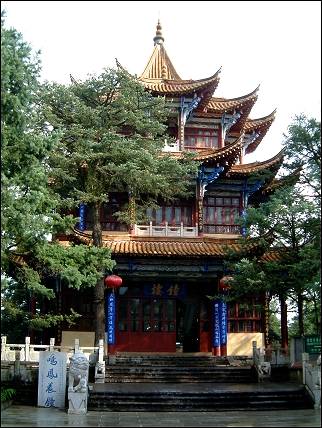
|
We visit the Golden Tempel, 11 kilometers northeast of Kunming in a pine forest on the peak of the Phoenix Song Mountain.
The Taoist temple sits on a marble terrace, at the top of stone stairs which passes through four Heavenly Gates. The original temple from 1604 was moved to Jizushan in West Yunnan. Just like its predecessor, the current building, which dates from the Qing dynasty, is made of copper. The building is 6.5 meters high and weighs 300 tons.
In the park is a 600 years old camomille tree which has hundred of red flowers every February. Behind the temple is a tower with three floors, in which a 14 tons bronze bell (1432) hangs. The sound of the bell can be heard all over the mountain.
Our visit to the Golden Temple concludes our visit to Yunnan. We will spend a night in Beijing and then fly back home.